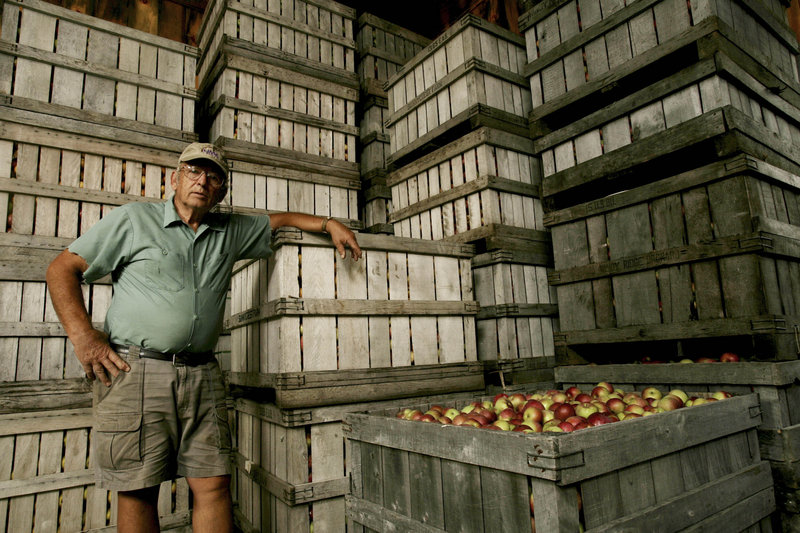CONCORD, N.H. – The answering machine message at Spiller Farms in Wells, Maine, cuts to the chase: “May 11 froze our apple crop.”
While many apple growers across the nation are enjoying an earlier-than-usual harvest, many in New England and parts of the Upper Midwest are reeling from the effects of two hard frosts in May.
The U.S. Department of Agriculture forecasts the apple crop in every New England state except Rhode Island will be down by almost 20 percent compared to last year.
Frank Bushy, owner of Giles Family Farm in Alfred, Maine, said he can’t recall in 30 years at the orchard losing 40 percent of his crop, and it could have been worse.
“We were within 1 degree of losing everything,” Bushy said. “I wouldn’t call it a frost. It was a freeze — 24 degrees. We were pretty much past bloom. At 28-29 degrees we would have been all set.”
Dick Fabrezio, owner of Windy Ridge Orchard in North Haverhill, N.H., said he lost 80 percent of his apple crop — upwards of 5,000 bushels.
“We sell and make cider here, but all our cider apples will be bought this year,” Fabrezio added, saying he has never before had to buy apples for cider.
The frosts wreaked particular havoc because they came after an unseasonably warm spring in which apple trees blossomed early, making them most vulnerable to the mid-May frosts.
“May 11 is one of those dates you’ll never forget,” said Bill Lord, fruit specialist with the University of New Hampshire Cooperative Extension service, of the first day temperatures plunged in the region. Lord said most trees in New England were in full bloom when the sub-freezing temperatures hit.
Nationwide, the apple production forecast is down by only 5 percent, offset by a bumper crop in Washington — the nation’s top apple grower.
Washington is forecast to harvest 250 million pounds over last year’s crop of 5.4 billion pounds of apples. The additional pounds of apples expected are more than the combined harvest of New England last year, which was 169 million pounds.
Still, pick-your-own orchards and smaller farms that supply local retailers are part of the fabric of a New England autumn, so the loss is acute.
Alyson’s Apple Orchard in Walpole, N.H., also lost 80 percent of its crop. That loss had a ripple effect on local wine and hard-cider maker Steve Miner, who owns Silver Mountain Ciders in Lempster. Alyson’s supplies the heirloom apples that Miner uses in most of his products.
Miner said he can’t find heirlooms — the baldwins and the russets — anywhere else. He said he would probably cut production in half this year — to under 2,000 gallons — and resort to wines he’s been stockpiling in the event of a bad year.
“I knew something like this would happen some day,” Miner said. “I just didn’t think it would be this bad.”
Massachusetts suffered pockets of loss, but nothing like Vermont, New Hampshire and Maine, said Jon Clements, fruit specialist for the University of Massachusetts Extension Service.
Tom Clark, owner of Clarkdale Fruit Farm in Deerfield, Mass., said he lost upwards of 25 percent of his apple crop from trees in lower elevations on his farm.
“It’s just depressing to go to the trees normally full of fruit and see nothing,” Clark said. “There’s a saying that fruit growers don’t go to the racetrack or the casino because they gamble at home.”
New York state, the nation’s second largest apple producer, is projected by the USDA to be down almost 8 percent — 180 million pounds less — below last year’s yield.
Michigan is ranked third for apple production, and its freeze was just as severe.
Send questions/comments to the editors.



Success. Please wait for the page to reload. If the page does not reload within 5 seconds, please refresh the page.
Enter your email and password to access comments.
Hi, to comment on stories you must . This profile is in addition to your subscription and website login.
Already have a commenting profile? .
Invalid username/password.
Please check your email to confirm and complete your registration.
Only subscribers are eligible to post comments. Please subscribe or login first for digital access. Here’s why.
Use the form below to reset your password. When you've submitted your account email, we will send an email with a reset code.